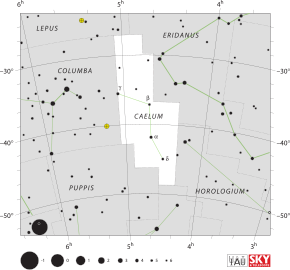| Constellation | |
 | |
| Abbreviation | Cae |
|---|---|
| Genitive | Caeli[1] |
| Pronunciation | /ˈsiːləm/, genitive /ˈsiːlaɪ/ |
| Symbolism | the chisel |
| Right ascension | 04h 19.5m to 05h 05.1m [2] |
| Declination | −27.02° to −48.74°[2] |
| Area | 125 sq. deg. (81st) |
| Main stars | 4 |
| Bayer/Flamsteed stars | 8 |
| Stars with planets | 1 |
| Stars brighter than 3.00m | 0 |
| Stars within 10.00 pc (32.62 ly) | 0 |
| Brightest star | α Cae (4.45m) |
| Messier objects | 0 |
| Meteor showers | 1 |
| Bordering constellations | Columba Lepus Eridanus Horologium Dorado Pictor |
| Visible at latitudes between +40° and −90°. Best visible at 21:00 (9 p.m.) during the month of January. | |
Caelum /ˈsiːləm/ is a faint constellation in the southern sky, introduced in the 1750s by Nicolas Louis de Lacaille and counted among the 88 modern constellations. Its name means "chisel" in Latin, and it was formerly known as Caelum Sculptorium ("Engraver's Chisel"); it is a rare word, unrelated to the far more common Latin caelum, meaning "sky", "heaven", or "atmosphere".[3] It is the eighth-smallest constellation, and subtends a solid angle of around 0.038 steradians, just less than that of Corona Australis.
Due to its small size and location away from the plane of the Milky Way, Caelum is a rather barren constellation, with few objects of interest. The constellation's brightest star, Alpha Caeli, is only of magnitude 4.45, and only one other star, (Gamma) γ1 Caeli, is brighter than magnitude 5 . Other notable objects in Caelum are RR Caeli, a binary star with one known planet approximately 20.13 parsecs (65.7 ly) away; X Caeli, a Delta Scuti variable that forms an optical double with γ1 Caeli; and HE0450-2958, a Seyfert galaxy that at first appeared as just a jet, with no host galaxy visible.
- ^ Cite error: The named reference
tirionconstwas invoked but never defined (see the help page). - ^ a b Cite error: The named reference
boundarywas invoked but never defined (see the help page). - ^ Charlton T. Lewis, Ph.D. and. Charles Short, A Latin Dictionary Oxford University Press, 1879. Entries for caelum and caelum.